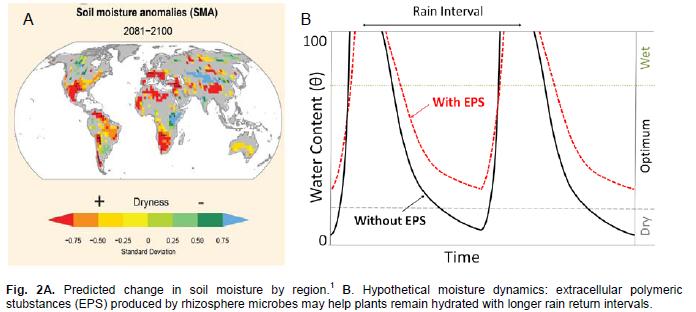Effect of Soil Structure and Microbial Matrix Production on Water Retention
Globally more than 2 billion people are now experiencing severe water stress with >40% of their local freshwater supplies already allocated to agriculture, industry, and domestic use.1 Widespread drought and famine could easily threaten economic and political stability around the world. In this project, we are investigating the potential for microbial extracellular polymeric substances (EPS) to retain moisture in soil, and possibly moderate the soil-drying effects of climate change (Fig. 2A). It has long been known that as little as 1% EPS can dramatically shift equilibrium moisture retention in soil.2 Soil microbes that secrete EPS could slow the rate of water loss from soils through binding water in gels and improving soil structure. A slower drying rate could mean soils are within the optimum moisture range longer, until the next rain event (Fig. 2B).

Currently, we are measuring the dynamics of water loss using microdevices to replicate soil microstructures. A 3D packing algorithm was used to create realistic 2D maps of silt-sized particles. These maps were imported into the technical drawing program AutoCAD, tiled, then microdevices were fabricated using photolithography and soft lithography (Fig. 3A). Replicate microdevices are then filled with muccoid (EPS+) or non-muccoid (EPS-) Sinorhizobium meliloti. Finally, devices are placed in a constant humidity control chamber (Fig 3B), and water content is measured with time as a function of soil structure and EPS type. Preliminary results in microdevices show clear moisture retaining effects of microbial EPS production (Fig 3C).

Collaborators: Dr. Jessica Chau, Dr. Dan Gage
Funding: USDA
1. Oki, T. & Kanae, S. Global Hydrological Cycles and World Water Resources. Science 313, 1068 - 1072 (2006).
2. Roberson, E. B. & Firestone, M. K. Relationship between desiccation and exopolysaccharide production in a soil Pseudomonas sp. . Appl Environ Microbiol. 58, 1284-1291 (1992).
3. Orner, E. et al. Pore-Scale Effects of Soil Structure And Microbial EPS Production On Soil Water Retention AGU Fall Meeting (2013).